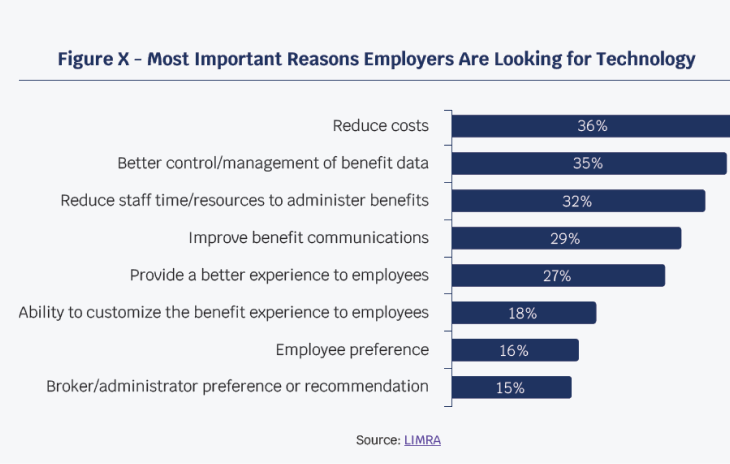The past few years have been transformative for workplaces. The challenges of the pandemic, the rising market competition, the Great Resignation, and the ongoing battle for top talent have urged employers to evaluate their recruitment methods to stand out.
But aside from attracting talent, employers are focused on holding onto the talent they have with new retention strategies – including a revolution in the world of employee benefits. What was once a given as part of a competitive compensation package has become a key differentiator in courting the best candidates.
However, there is more to the benefits equation. Offering competitive benefits helps, but employers are increasingly realizing the importance of supporting employees in getting the most out of their benefits packages. This includes implementing benefits technology to streamline the onboarding and administration processes and broaden their benefits offerings to rise to the top of a desirable pool of job offers.
What Is Benefits Technology?
Benefits technology refers to the use of digital tools and platforms to administer and manage employee benefits programs within organizations. These technologies streamline the process of offering, enrolling, and managing employee benefits such as healthcare, retirement plans, insurance coverage, and wellness programs.
Benefits technology solutions typically include software applications, online portals, and mobile apps that automate various aspects of benefits administration, including enrollment, eligibility verification, plan selection, employee communications, and compliance reporting.
The primary goal of benefits technology is to simplify and enhance the employee benefits experience for both employers and employees.
By leveraging technology, organizations can improve the efficiency, accuracy, and transparency of benefits administration processes, while also providing employees with greater access to information and resources to make informed decisions about their benefits.
Additionally, benefits technology can help organizations better track and analyze benefits utilization, manage costs, and ensure compliance with regulatory requirements.
Overall, benefits technology plays a crucial role in modernizing and optimizing employee benefits programs to meet the needs of today’s workforce.

Enhancing the Recruitment Experience with Benefits Technology
Hiring is no longer a one-way street. Companies are being interviewed just as much as job candidates, and like candidates, they must stand out from equally worthy competitors to attract talent. Employee benefits technology plays an important role in streamlining the recruitment process and making a lasting impact.
Streamlining the Job Offer Process
Employee benefits technology enhances the recruitment process by making it more streamlined and efficient. Candidates can easily access and understand the benefits that are included in their job offer, taking some of the stress out of the process and keeping it transparent.
Helping with Employer Branding
In the fierce battle for talent, employer branding is at the forefront. The brand is an important part of the employee value proposition and demonstrates the company’s identity to current and prospective employees. It allows candidates to know the company’s business, vision, mission, values, and culture, helping them to decide if it is the right cultural fit.
According to a LinkedIn study, 72% of recruiting leaders worldwide agreed that employer brand has a significant impact on hiring. Benefits technology plays a crucial role in showcasing a company’s offerings in a digestible format, highlighting its unique benefits package, and enhancing the company’s image as a desirable workplace.
Reducing Human Error
HR technology for job candidates is important, but it can benefit the HR department as well.
With automated manual processes and streamlined data entry, benefits technology ensures accurate calculations and delivers accurate employee information to prevent costly mistakes and ensure your company is meeting its legal obligations, rather than relying on manual-prone methods. It tracks compliance-related documents to relieve the burden on HR professionals.
Automation also frees HR professionals to focus their attention on the mission-critical aspects of their role, such as cultivating relationships with prospective employees and maintaining strong relationships with current employees. It streamlines the administrative work for staff to spend more time on initiatives that contribute to the betterment of the workforce.

Improving Employee Retention with Benefits Technology
In many ways, retaining top talent is more important than attracting new hires. The average cost per new hire can be quite high and time-consuming, so it is much more cost-effective to hold onto current employees than to go through the hiring process on a regular basis.
Benefits technology can be a crucial part of the retention process with tools and resources that nurture loyalty in employees and make them invested in your company’s growth and success.
Streamlining Benefits Enrollment and Management
One of the key ways that employee benefits technology aids retention is by simplifying the benefits enrollment and management process. A centralized, user-friendly platform that allows employees to access and enroll in benefits – and manage existing benefits – eliminates a lot of the stress, confusion, and frustration that can arise with benefits management.
Employees then have an opportunity to take full advantage of their offerings, leading to a better experience and ensuring that they are using their benefits to their fullest.
For example, employees may need to make changes to their benefits in the event of major life changes, such as getting married, having a child, or experiencing health problems.
Ensuring Employee Well-being
Employee well-being is a big part of retention. According to Zippia, 80% of employees would work harder if they felt better appreciated, which includes having an employer that is invested in their health and wellness. Benefits technology supports employee well-being by providing resources for physical and mental health, as well as longterm financial health.
There are many ways a company can support employee well-being, including telehealth services, mental health resources, comprehensive wellness programs, and financial planning tools. Some platforms even offer personalized wellness recommendations based on each employee, providing a more tailored and positive experience.

Staying Competitive
Job-hopping is becoming more common because of the tight labor market. Over 22% of workers ages 20 and older spent a year or less at their jobs in 2022. Offering unique and personalized benefits packages can be what sets your company apart.
Benefits technology allows for continuous improvement and tailoring of benefits offerings based on employee feedback and evolving market trends. Instead of seeking out better opportunities and refusing to settle, employees can stay loyal to your company knowing that you will have their best interests in mind.

Implementing Benefits Technology
There is a revolution in the way employers are approaching employee recruitment and retention, and benefits technology is part of that. What was once a manual process with error-prone paperwork and administrative waste is now easier with electronic benefits platforms.
According to a LIMRA survey, 59% of employers use a technology platform for insurance benefit enrollment or administration. In addition, over one in three companies that do not have a benefits platform are currently seeking one.
Benefits technology can assist with the experience for the HR department or the employee experience, but it is best to choose a system that does both.
Typically, companies are seeking more benefits for HR with carriers, and employers nationwide. reduced costs, improved management, and optimized allocation of resources, but the focus should be on employee needs.
According to the survey, 80% of employers are looking for a platform that is accessible all year for administration and updates, instead of a simple enrollment platform. This is important not only for the HR department but enrolling new hires and supporting major life events that necessitate coverage changes. Likewise, based on the same survey, 77% of employers want a centralized technology platform, no matter what carriers they have for employee benefits. Having all benefits consolidated on one platform helps employers save time and makes the experience seamless for employees.Another key aspect of a good benefits technology is a platform that seamlessly integrates with existing systems, including payroll, carrier, and HRIS systems.
While many of these concerns are focused more on the employer’s own needs, these features do provide value to employees. About 85% of employers think that having an easy-to-use and intuitive platform is important to ensure that both their HR staff and employee users will make the best use of the platform.
Leverage Benefits Technology to Stay Ahead in the Rising Competition for Top Talent
The battle for top talent is intensifying, and today’s workforce has unique needs and demands not met by traditional benefits programs.
Job candidates are seeking flexibility, choice, and purpose in their work – and they are willing to look elsewhere if their employers are not meeting their needs.
Leveraging modern benefits technology is key for businesses looking to attract and retain top talent. Offering personalized benefits packages, and giving employees simple, transparent ways to access and adjust them, not only helps employees but reduces costs and administrative burden for employers.









